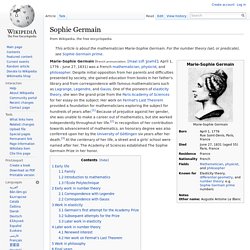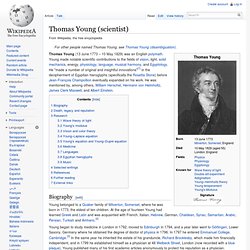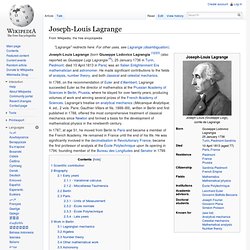

Sophie Germain. This article is about the mathematician Marie-Sophie Germain.

For the number theory (set, or predicate), see Sophie Germain prime. Early life[edit] Family[edit] Thomas Young (scientist) Thomas Young (13 June 1773 – 10 May 1829) was an English polymath.

André-Marie Ampère. André-Marie Ampère (20 January 1775 – 10 June 1836)[1] was a French physicist and mathematician who is generally regarded as one of the main founders of the science of classical electromagnetism, which he referred to as "electrodynamics".

The SI unit of measurement of electric current, the ampere, is named after him. Biography[edit] Andre-Marie Ampère was born on 20 January 1775 to Jean-Jacques Ampère, a prosperous businessman, and Jeanne Antoinette Desutières-Sarcey Ampère during the height of the French Enlightenment. Michael Faraday. Michael Faraday, FRS (22 September 1791 – 25 August 1867) was an English scientist who contributed to the fields of electromagnetism and electrochemistry.

His main discoveries include those of electromagnetic induction, diamagnetism and electrolysis. As a chemist, Faraday discovered benzene, investigated the clathrate hydrate of chlorine, invented an early form of the Bunsen burner and the system of oxidation numbers, and popularised terminology such as anode, cathode, electrode, and ion.
Faraday ultimately became the first and foremost Fullerian Professor of Chemistry at the Royal Institution of Great Britain, a lifetime position. Faraday was an excellent experimentalist who conveyed his ideas in clear and simple language; his mathematical abilities, however, did not extend as far as trigonometry or any but the simplest algebra. Personal life Early life Adult life. Nicolas Léonard Sadi Carnot. Nicolas Léonard Sadi Carnot (French: [kaʁno]; 1 June 1796 – 24 August 1832) was a French military engineer and physicist, often described as the "father of thermodynamics".

In his only publication, the 1824 monograph Reflections on the Motive Power of Fire, Carnot gave the first successful theory of the maximum efficiency of heat engines. Carnot's work attracted little attention during his lifetime, but it was later used by Rudolf Clausius and Lord Kelvin to formalize the second law of thermodynamics and define the concept of entropy. Benjamin Franklin. Benjamin Franklin FRS (January 17, 1706 [O.S.

Johann Heinrich Lambert. Johann Heinrich Lambert (German: [ˈlambɛʁt], Jean-Henri Lambert in French; 26 August 1728 – 25 September 1777) was a Swiss mathematician, physicist, philosopher and astronomer.

He is best known for proving the Irrationality of π. Asteroid 187 Lamberta was named in his honour. James Watt. James Watt, FRS, FRSE (30 January 1736 (19 January 1735 O.S.)–25 August 1819)[1] was a Scottish inventor and mechanical engineer whose improvements to the Newcomen steam engine were fundamental to the changes brought by the Industrial Revolution in both his native Great Britain and the rest of the world.

Watt attempted to commercialise his invention, but experienced great financial difficulties until he entered a partnership with Matthew Boulton in 1775. The new firm of Boulton and Watt was eventually highly successful and Watt became a wealthy man. In his retirement, Watt continued to develop new inventions though none were as significant as his steam engine work. He died in 1819 at the age of 83. Joseph Louis Lagrange. Joseph-Louis Lagrange (born Giuseppe Lodovico Lagrangia [1][2][3] (also reported as Giuseppe Luigi Lagrangia [4]), 25 January 1736 in Turin, Piedmont; died 10 April 1813 in Paris) was an Italian Enlightenment Era mathematician and astronomer.

He made significant contributions to the fields of analysis, number theory, and both classical and celestial mechanics. In 1766, on the recommendation of Euler and d'Alembert, Lagrange succeeded Euler as the director of mathematics at the Prussian Academy of Sciences in Berlin, Prussia, where he stayed for over twenty years, producing volumes of work and winning several prizes of the French Academy of Sciences. Lagrange's treatise on analytical mechanics (Mécanique Analytique, 4. ed., 2 vols. Paris: Gauthier-Villars et fils, 1888–89), written in Berlin and first published in 1788, offered the most comprehensive treatment of classical mechanics since Newton and formed a basis for the development of mathematical physics in the nineteenth century.
Pierre-Simon Laplace. Pierre-Simon, marquis de Laplace (/ləˈplɑːs/; French: [pjɛʁ simɔ̃ laplas]; 23 March 1749 – 5 March 1827) was a French mathematician and astronomer whose work was pivotal to the development of mathematical astronomy and statistics.

He summarized and extended the work of his predecessors in his five-volume Mécanique Céleste (Celestial Mechanics) (1799–1825). This work translated the geometric study of classical mechanics to one based on calculus, opening up a broader range of problems. In statistics, the Bayesian interpretation of probability was developed mainly by Laplace.[2] Laplace formulated Laplace's equation, and pioneered the Laplace transform which appears in many branches of mathematical physics, a field that he took a leading role in forming.
The Laplacian differential operator, widely used in mathematics, is also named after him. Mikhail Lomonosov. Mikhail Vasilyevich Lomonosov (Russian: Михаи́л Васи́льевич Ломоно́сов, IPA: [mʲɪxɐˈil vɐˈsʲilʲjɪvʲɪtɕ ləmɐˈnosəf] ( ); November 19 [O.S. November 8] 1711 – April 15 [O.S. Joseph Fourier. Biography[edit] Fourier was born at Auxerre (now in the Yonne département of France), the son of a tailor. He was orphaned at age nine. John Dalton.